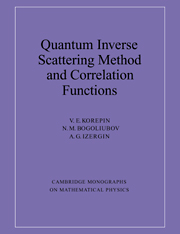Book contents
- Frontmatter
- Contents
- Preface
- Part I The Coordinate Bethe Ansatz
- Part II The Quantum Inverse Scattering Method
- Introduction to Part II
- V The Classical r-matrix
- VI The Quantum Inverse Scattering Method
- VII The Algebraic Bethe Ansatz
- VIII Lattice Integrable Models of Quantum Field Theory
- Part III The Determinant Representation for Quantum Correlation Functions
- Part IV Differential Equations for Quantum Correlation Functions
- Final Conclusion
- References
- Index
VI - The Quantum Inverse Scattering Method
Published online by Cambridge University Press: 04 August 2010
- Frontmatter
- Contents
- Preface
- Part I The Coordinate Bethe Ansatz
- Part II The Quantum Inverse Scattering Method
- Introduction to Part II
- V The Classical r-matrix
- VI The Quantum Inverse Scattering Method
- VII The Algebraic Bethe Ansatz
- VIII Lattice Integrable Models of Quantum Field Theory
- Part III The Determinant Representation for Quantum Correlation Functions
- Part IV Differential Equations for Quantum Correlation Functions
- Final Conclusion
- References
- Index
Summary
Introduction
The quantum inverse scattering method (QSIM) appears as the quantized form of the classical inverse scattering method. It allows us to reproduce the results of the Bethe Ansatz and to move ahead. QISM is now a well developed branch of mathematical physics. In this chapter the fundamentals of QISM are given and illustrated by concrete examples.
In section 1 the general scheme of QISM, which allows the calculation of commutation relations between elements of the transfer matrix (necessary to construct eigenfunctions of the Hamiltonian in Chapter VII) is presented, and the quantum R-matrix is introduced. As in the classical case, the existence of an R-matrix and trace identities ensures that a Lax representation for the model exists. Thus, there are infinitely many conservation laws.
The Yang-Baxter equation, which is satisfied by the R-matrix, is discussed in section 2. Some important features of the R-matrix are also mentioned. The trace identities for the quantum nonlinear Schrödinger equation are proved in section 3. The general scheme of QISM is applied to the quantum sine-Gordon and Zhiber-Shabat-Mikhailov models in section 4. Spin models of quantum statistical physics are discussed in section 5. It is shown that a fundamental spin model can be constructed with the help of any given R-matrix.
The connection between classical statistical models on a two-dimensional lattice and QISM is established in section 6. QISM is the generalization of the classical inverse scattering method.
- Type
- Chapter
- Information
- Quantum Inverse Scattering Method and Correlation Functions , pp. 115 - 136Publisher: Cambridge University PressPrint publication year: 1993
- 1
- Cited by

